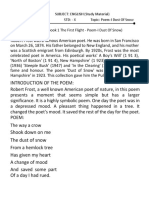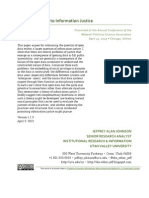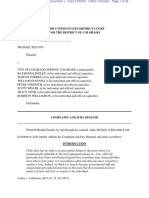Dust of Snow
Dust of Snow
Uploaded by
nithyasen17Copyright:
Available Formats
Dust of Snow
Dust of Snow
Uploaded by
nithyasen17Original Title
Copyright
Available Formats
Share this document
Did you find this document useful?
Is this content inappropriate?
Copyright:
Available Formats
Dust of Snow
Dust of Snow
Uploaded by
nithyasen17Copyright:
Available Formats
DUST OF SNOW
SUMMARY
This is a short poem by Robert Frost that throws light upon the healing attitude of nature
and how little things can change your way of thinking and brighten up your whole day.
One day the poet was also experiencing a bad day and was sitting under a hemlock tree.
Suddenly, a crow came and shook the dust of snow upon the poet and instantly made him
happier.
He realized that he was sad about petty issues in life. The tree is poisonously combined with a
crow that is an indicator of doom and fear but for him and in the poem these are carriers of
happiness.
Literary Devices in Dust of Snow
Alliteration – Repetition of same consonant sound in consecutive or nearby words.
Has given my heart – ‘h’ sound has been repeated.
And saved some part –‘s’ sound has been repeated.
Assonance – Repetition of vowel sound in consecutive or nearby words.
Shook down on me – ‘o’ sound has been repeated
Enjambment – continuation of a sentence to the next line. Here the entire poem is a
continuous line.
SHORT TYPE QUESTIONS
1. How has the poet observed nature in the poem ‘Dust of Snow’
The poet has observed nature as a positive medium of change for him. The poet had been the
sorrowful and depressive mood in the poem. But then the way a crow shook snow dust off, it
changed his mood. Nature gave him the inspiration to behave in a positive manner.
2. What is the underlying message for us in our hectic life with reference to the poem,
‘Dust of Snow’?
In the poem ‘Dust of Snow’, the poet wants to convey that sometimes certain moments or
actions which are simple have larger significance. They can change the mood or life of a
person. The way a crow shakes down dust of snow on the poet inspires and gives him the
idea to shake off his depressive thoughts, become cheerful and do something useful.
3. What side of nature do ‘crow’ and ‘hemlock’ represent?
‘Crow’ is a black, harsh-voiced bird and ‘hemlock’ is a tree with poisonous bitter fruit. Both
are not beautiful. They represent the dark, depressive, sorrowful and bitter side of nature.
4. Why does the poet use such poetically uncommon bird and tree? What does it reflect?
The poet seems to be in a depressed and sorrowful mood. In such a mood, one cannot think of
a sweet and beautiful side of nature. The harsh, bitter and poisonous images come to his
mind. That is why he uses an uncommon, harsh, ugly crow and poisonous tree like hemlock.
5. Justify the role of the crow in the poem “Dust of Snow” in changing the poet’s mood.
I think, ‘the way snow dust was shaken off’ changed his mood. Perhaps it gave the poet
inspiration/idea to behave in the same manner—shake off his depressive thoughts and revive
his cheerful mood.
6. What did the poet think of the day before the dust of snow fell on him?
Before the fall of the dust of snow, the poet thought that his day was ruined. He was in a bad
mood. But then use of snow fell on him. It signalled something good and joyful. His mood
changed.
7. Write a note on the setting of the poem.
The poem presents a perfect setting. There are four elements in the poem. All these four
elements match one another. The snow stands for depression. The hemlock tree is a symbol
of sadness. The crow considered ominous. The poet’s mood was also sad. But suddenly the
way in which the crow shook the hemlock tree and falling off the dust of snow change the
poet’s mood.
8. Do you think that the poet presents a very bright or cheerful side of nature in the
poem? Give a reasoned answer.
No, Robert Frost has presented nature in its elemental and raw form. It is quite dull and
depressive wintry day. The fall of fine dust of snow does bring a sudden change in the mood
of the poet. It refreshes his spirits and brings cheerfulness to his depressed spirits and mood.
9. Why does the poet say that he had `saved some part of a day I (he) had rued’?
The whole day had been rather gloomy, dull and hopeless. The poet had a feeling that the
whole day would go waste. However, the falling of fine dust of snow on him suddenly
changes his mood. It cheered his depressed spirits. He felt as if he had saved some part of the
day.
10. What is the message that Robert Frost wants to convey to the readers in the poem
‘Dust of snow’?
Robert Frost gives quite a positive message to the readers. Depression and hopelessness do
cloud our hearts, spirits and moods. However, there is a silver-lining beyond every cloud. The
poet had given up all hopes and declared that the whole day would go waste. Suddenly, the
falling of fine dust of snow on him brings a sudden change in his mood. Cheerfulness
replaces the feeling of regret.
Long Answer Type Questions
1. Our attitude towards a situation evokes both negative and positive response. Analyze
this with reference to the poem, ‘Dust of Snow’ to bring out the inherent valuable
lessons.
Whatever situation life throws at us, it evokes both positive and negative responses. The poet,
in the poem ‘Dust of Snow,’ was in a sorrowful mood. However, when a crow shook down
the ‘dust of snow’ on him, his bitter mood changed into a more optimistic one. Now, being in
a sorrowful or bad mood already, the poet could have got angry at the crow also. However,
the dust of snow becomes a positive medium of change for him. It made him cheerful to some
extent and helped him forget his sadness, at least for a few moments. Thus, we see that
instead of seeing the negative aspect of a happening, one should see the positive aspect, and
one’s response may greatly affect the outcome of incidents.
2. There are times when we feel depressed and hopeless. We think that things will never
change. Suddenly, a change comes in our mood when cheerfulness replaces the sense of
regret. Justify the above statement in the context of the poem ‘Dust of Snow’.
Change is the law of nature. Man’s mood and spirits change like the change of the weather.
In the poem, the poet is in a depressed and hopeless mood. He feels that the whole of the day
has been wasted. But fortunately, this is not so. The falling of the fine dust of snow on him
brings a sudden change in his mood. He realises that all is not lost. There is still hope for
redemption. No doubt, a large part of the day has already been lost. It has been rather a bad
day so far. But no more now. Now a part of the day has been redeemed. The change of
landscape has changed his mood. Cheerfulness had replaced the feeling of regret. His spirits
are no more depressed. The sudden change outside also cheers his heart and mood.
You might also like
- Study Work Guide: Vistas of Poems Grade 11 First Additional LanguageFrom EverandStudy Work Guide: Vistas of Poems Grade 11 First Additional LanguageRating: 5 out of 5 stars5/5 (1)
- Regulations For The MESDocument270 pagesRegulations For The MESrajabanerjee782% (17)
- Snow PoemDocument7 pagesSnow PoemVinod Kr100% (2)
- Idk ManDocument22 pagesIdk Manyuvansarathy107No ratings yet
- Dust of Snow Extra QuestionsDocument3 pagesDust of Snow Extra Questionsmanan1.sushmaNo ratings yet
- Dust of Snow AnswerDocument4 pagesDust of Snow AnswerNItishNo ratings yet
- First 6 PoemsDocument36 pagesFirst 6 PoemsSukhwinder singhNo ratings yet
- Dust of Snow Class 10Document9 pagesDust of Snow Class 10Sukhwinder singhNo ratings yet
- Poem-1 Dust of SnowDocument5 pagesPoem-1 Dust of Snownaitikgam75No ratings yet
- Dust of Snow NotesDocument5 pagesDust of Snow NotesurwamanveethNo ratings yet
- NYx GUZe STF 7 o 8 y KKD 2 AjDocument6 pagesNYx GUZe STF 7 o 8 y KKD 2 Ajabhinavjat15391No ratings yet
- Revision - Dust of SnowDocument5 pagesRevision - Dust of Snowjdh-22023No ratings yet
- P1 - STUDY MATERIAL Class XDocument2 pagesP1 - STUDY MATERIAL Class Xkiku.sanghaviNo ratings yet
- DustofSnowDocument2 pagesDustofSnowlakshaybemasterNo ratings yet
- Dust of SnowDocument8 pagesDust of Snowgyanprasad309No ratings yet
- Dust of SnowDocument3 pagesDust of SnowAkshayaNo ratings yet
- DUST of SNOW_Q-ADocument2 pagesDUST of SNOW_Q-Aarmankaur239sherryNo ratings yet
- English Class 10 Dust of SnowDocument7 pagesEnglish Class 10 Dust of Snowshafiqul222No ratings yet
- Dust of SnowDocument5 pagesDust of SnowGaurav SinghNo ratings yet
- .TSD - X - CB - Eng - Dust of SnowDocument4 pages.TSD - X - CB - Eng - Dust of SnowXYZNo ratings yet
- 1332310-Dust of Snow - Class 10 Question BankDocument9 pages1332310-Dust of Snow - Class 10 Question Bankabhinavjat15391No ratings yet
- Dust of Snow (Notes) Std. 10Document2 pagesDust of Snow (Notes) Std. 10mhschoolclassNo ratings yet
- KeytodustDocument5 pagesKeytodustathipharma.78No ratings yet
- Question Bankdust of SnowDocument8 pagesQuestion Bankdust of SnowSaumit SurekaNo ratings yet
- Dust of Snow IntroductionDocument6 pagesDust of Snow IntroductionSelanMable100% (1)
- Bulletins-Buzf85cwnc1b-P1 Dust of Snow NotesDocument2 pagesBulletins-Buzf85cwnc1b-P1 Dust of Snow Notespinashah2102No ratings yet
- Dust of Snow Notes Class 10Document5 pagesDust of Snow Notes Class 10Sandhya DubeyNo ratings yet
- Dust of Snow Notes 2Document5 pagesDust of Snow Notes 2Sharon ShajanNo ratings yet
- poemsDocument57 pagespoemssanubagade2022No ratings yet
- X - Poem - 1 - Dust of Snow - NotesDocument6 pagesX - Poem - 1 - Dust of Snow - Noteskishan jhaNo ratings yet
- CBSE Class 10 English Dust of Snow Poem SummaryDocument1 pageCBSE Class 10 English Dust of Snow Poem SummaryDR GokuNo ratings yet
- Dust of Snow NEW 2022Document4 pagesDust of Snow NEW 2022ilikecatscuzwhynotNo ratings yet
- Dust of SnowDocument3 pagesDust of Snowmdusuf25nsnNo ratings yet
- Manisha Singh Work Duing Novel Corona VirusDocument7 pagesManisha Singh Work Duing Novel Corona VirusManisha SinghNo ratings yet
- Dust of Snow - FROST - FINALDocument7 pagesDust of Snow - FROST - FINALmanojboaNo ratings yet
- Dust of SnowDocument2 pagesDust of Snowakshaymonk45No ratings yet
- Dust of Snow (Summary)Document8 pagesDust of Snow (Summary)Remya SNo ratings yet
- Long Answer QuestionsDocument1 pageLong Answer QuestionsJames PaulNo ratings yet
- Dust of Snow x25Document5 pagesDust of Snow x25SwadhinNo ratings yet
- Dust of Snow (A)Document4 pagesDust of Snow (A)manojboaNo ratings yet
- Dust of SnowDocument2 pagesDust of SnowPavan JayaprakashNo ratings yet
- 1.1 Dust of SnowDocument3 pages1.1 Dust of Snow9ghfx4gdc5No ratings yet
- 253download. - 0POEM 1 CLASS X ENGLISHDocument4 pages253download. - 0POEM 1 CLASS X ENGLISHRemya SNo ratings yet
- English 10th PoemDocument38 pagesEnglish 10th Poemgargminal93No ratings yet
- Class 10TH English Dust of Snow Question & AnswersDocument2 pagesClass 10TH English Dust of Snow Question & Answersakankshapanchal201No ratings yet
- Dust of extra questionsDocument4 pagesDust of extra questionsnandusworld20No ratings yet
- Last Min Revision Literature 9G 10)Document5 pagesLast Min Revision Literature 9G 10)y7dxwy6zddNo ratings yet
- Dust of SnowDocument13 pagesDust of Snowrauteladiya183No ratings yet
- Dust of Snow Question and AnswerDocument4 pagesDust of Snow Question and Answermaaman30102009No ratings yet
- The Dust of Snow PDFDocument7 pagesThe Dust of Snow PDFtrevin79saiNo ratings yet
- Dust of SnowDocument12 pagesDust of SnowyogeshNo ratings yet
- English - Poem Dust of Snow Notes (X)Document1 pageEnglish - Poem Dust of Snow Notes (X)Palak kumariNo ratings yet
- Poem - Dust of Snow (Notes) - 9360Document3 pagesPoem - Dust of Snow (Notes) - 9360gunn.nidhaan.singh313No ratings yet
- Poem - Dust of Snow (First Flight Book)Document2 pagesPoem - Dust of Snow (First Flight Book)Ojasvi PaliwalNo ratings yet
- Poem 1 (Dust of Snow)Document4 pagesPoem 1 (Dust of Snow)sewenNo ratings yet
- Poetry-Dust of Snow (Robert Frost) Lesson Explanation Stanza ExplanationDocument4 pagesPoetry-Dust of Snow (Robert Frost) Lesson Explanation Stanza ExplanationANANYA CHUGHNo ratings yet
- Dust of SnowDocument4 pagesDust of Snowaalia hasanNo ratings yet
- Buru 2Document4 pagesBuru 2Sumantra ChattopadhyayNo ratings yet
- (Dust of Snow) & 2 (Fire and Ice) - NotesDocument3 pages(Dust of Snow) & 2 (Fire and Ice) - NotesdakshNo ratings yet
- Dust of SnowDocument6 pagesDust of SnowbihariNo ratings yet
- Sample Term Paper ProposalDocument8 pagesSample Term Paper Proposalafmzxutkxdkdam100% (1)
- Aaa Replica Handbags Wallets Scarves Belts For Salekjaub PDFDocument1 pageAaa Replica Handbags Wallets Scarves Belts For Salekjaub PDFballe83rafnNo ratings yet
- Plans For PhotoshootDocument5 pagesPlans For PhotoshootLuke CorbishleyNo ratings yet
- Surehatch Pricelist 2020 PDFDocument23 pagesSurehatch Pricelist 2020 PDFHadrien Faryala100% (1)
- 7 5+days+ratiosDocument1 page7 5+days+ratiosAli KaraNo ratings yet
- Sustainability 11 04489 v2Document16 pagesSustainability 11 04489 v2Khadija NasirNo ratings yet
- Part Submission Warrant: Organization Manufacturing Information Customer Submittal InformationDocument1 pagePart Submission Warrant: Organization Manufacturing Information Customer Submittal Informationkrds chidNo ratings yet
- Task 1Document1 pageTask 1PheoNo ratings yet
- Mastering Public RelationsDocument4 pagesMastering Public RelationsOneeba MalikNo ratings yet
- Delhi Sultanate Conquest and ConsolidationDocument36 pagesDelhi Sultanate Conquest and ConsolidationDiplina SahariaNo ratings yet
- Danh Sách TVTKDocument45 pagesDanh Sách TVTKLợi TrầnNo ratings yet
- No Tolerance For Intolerant SpeechDocument24 pagesNo Tolerance For Intolerant Speechyszrdss9btNo ratings yet
- The General Agreement On Tariffs and Trade (GATT) and World Trade OrganizationDocument20 pagesThe General Agreement On Tariffs and Trade (GATT) and World Trade OrganizationCristian PALMANo ratings yet
- From Open Data To Information JusticeDocument21 pagesFrom Open Data To Information JusticeTomás AguerreNo ratings yet
- Professional Ethics in IT Social & Professional I FINALSDocument54 pagesProfessional Ethics in IT Social & Professional I FINALSRichard HaliliNo ratings yet
- July 2020 Lawsuit: Michael Sexton v. City of Colorado Springs, Et Al.Document28 pagesJuly 2020 Lawsuit: Michael Sexton v. City of Colorado Springs, Et Al.Michael_Roberts2019No ratings yet
- Language Test 9aDocument3 pagesLanguage Test 9aSebastian KORCZAKNo ratings yet
- Stockholm Declaration 1972 Rio Declaration 1992 (SHELTON)Document13 pagesStockholm Declaration 1972 Rio Declaration 1992 (SHELTON)08Anay MangalNo ratings yet
- The Forgotten Genocide Eastern Christians, The Last Arameans (Sébastien de Courtois)Document402 pagesThe Forgotten Genocide Eastern Christians, The Last Arameans (Sébastien de Courtois)hunter ZNo ratings yet
- Pre-Trial SPA W/ AcknowledgementDocument2 pagesPre-Trial SPA W/ AcknowledgementN.A. BrualNo ratings yet
- MGT Capstone 1 - 4Document3 pagesMGT Capstone 1 - 4Shakeel SajjadNo ratings yet
- Retail Cover Letter Template No ExperienceDocument7 pagesRetail Cover Letter Template No Experiencef1vijokeheg3100% (2)
- HSSC Part-Ii (Commerce Private)Document5 pagesHSSC Part-Ii (Commerce Private)weecoodeNo ratings yet
- Jessel Pds Copy3Document5 pagesJessel Pds Copy3Jessel Andria CañebaNo ratings yet
- (PM2-01 I TPL v3 0 1) Project - Initiation - Request (ProjectName) (Dd-Mm-Yyyy) (VX X)Document4 pages(PM2-01 I TPL v3 0 1) Project - Initiation - Request (ProjectName) (Dd-Mm-Yyyy) (VX X)Ana-Maria StasNo ratings yet
- EMPTECH 3rd Quarterly ExamDocument2 pagesEMPTECH 3rd Quarterly ExamyhanatimpugNo ratings yet
- The SunsetDocument1 pageThe SunsetHennessy VasquezNo ratings yet
- Adat Law in IndonesiaDocument7 pagesAdat Law in Indonesiaalicia pandoraNo ratings yet
- MAKAUT Prospectous - NewDocument10 pagesMAKAUT Prospectous - NewMahi mallikNo ratings yet

























































































